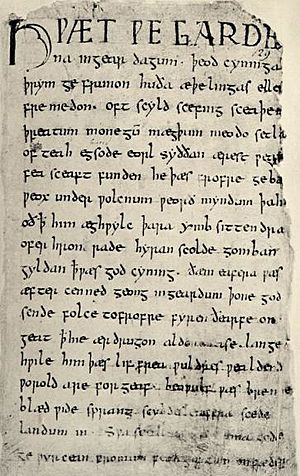Old English poetry facts for kids

The earliest known English poem is a hymn on the creation. Bede says this was by Cædmon (flourished 658–680). He was, according to legend, an illiterate herdsman who produced poetry at a monastery at Whitby. This is probably the earliest written Anglo-Saxon poetry we have.
Much of the poetry of the period is difficult to date, or even to arrange chronologically. Estimates for the date of the great epic Beowulf range from AD 608 through to AD 1000, and there has never been agreement.
It is possible to identify some key moments. The Dream of the Rood was written before about AD 700, when parts were carved in runes on the Ruthwell Cross. Some poems on historical events, such as The Battle of Brunanburh (937) and The Battle of Maldon (991), seem to have been written shortly after the events, so they can be dated reasonably precisely.
Anglo-Saxon poetry is known by the manuscripts in which it survives. The most important manuscripts are from the late 10th and early 11th centuries. They are known as the Cædmon manuscript, the Vercelli Book, the Exeter Book, and the Beowulf manuscript.
Beowulf is the only heroic epic to have survived in its entirety, but fragments of others show that it was not unique in its time. Other genres include much religious verse, from devotional works to biblical paraphrase.
With one notable exception (the so-called Rhyming Poem), Anglo-Saxon poetry depends on alliteration for its structure. Any rhyme included is just ornamental.
Images for kids
-
The Peterborough Chronicle, in a hand of about 1150, is one of the major sources of the Anglo-Saxon Chronicle; the initial page
-
Remounted page from Beowulf, British Library Cotton Vitellius A.XV




